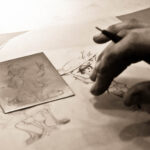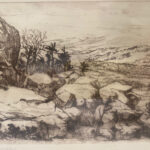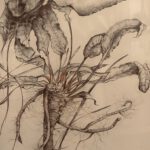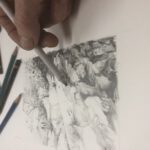My knuckle settles on the copper plate, carefully, not to disturb the wax crayon sketch on the polished surface. A sharp drypoint stylus is held firmly in place. Work begins by dragging that stylus across the copper raising the burr, which looks ragged and irregular. There will be fewer printed editions due to the fragility of that burr. The beauty of the drypoint print is the appealing softness in the picture.
This type of etching is closest to drawing, in spite of its shortcomings. No Nitric acid dips or chemical grounds to work with, so in that respect it is also healthier for you.
Traditional engraving with gravers and metal tipped pens, is clean, precise, sure to pull a print without too many issues and the burr is wiped away.
Dictionary definition for drawing:
A picture or diagram made with a pencil, pen, or crayon rather than paint.
This is a very modest description. Hardly covers the vast domain of drawing.
Drawing and drypoint are obviously different but very alike. Both disciplines are executed carefully in order to lay a line with either a sharp metal stylus or mechanical or wooden pencil leads 9H to 9B, black and color.
Crescent Rocks and Horseradish
My favorite papers to use for drypoint, German etching thick like a cotton sheet, whereas Illustration Bristol 400 weight with unforgiving tight weave surface is perfect.
Each job may require different paper, pencil leads and specialty inks. The list is varied. With my eye on the natural world I am comfortably happy working in both mediums.
Note the abstract-ish print called Boar Hunt which looks different, and happens to be a monotype etching, generally painted on the surface of the plate. I was using a rectangle of plexiglass for a palette and brush wiper, when it started to show some promise, so I decided to make a print.
I attended Corcoran School of Art in 1968-1970, but it was not a fully accredited college status until the following year 1971. My classes were core design, drawing, caligraphy and history of art. Any day in any design class was spent building mixed media structures, pop-ups, 3-D companion perspective sketches.
My drawing classes were spent looking studying the model and closing our eyes after memorizing the shape and textures to be put into our sketch pads. Contour drawing, using our peripheral vision, was a warm up exercise we practiced regularly and I still sometimes use. These two years were my first foray in the Art Study environment. I will verifiably state that what you think you see is not actually how you meant to interpret it on your paper. For better or worse every exercise was valuable.
The last thing I’ll share with you is my deep abiding respect for the power of art, the art of creating art and practitioners of art, new and old.
Artists affect social changes. We document life in our world.
This belief makes my work relevant.





